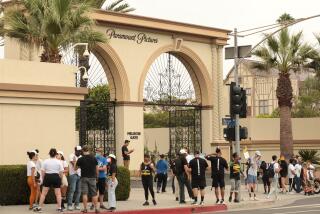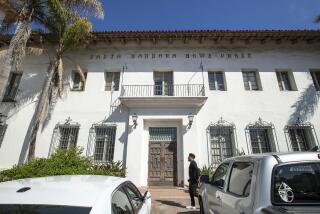Operating Pact Is Bittersweet End to Battle : Media: The Free Press is saved, and the combined newspapers may make up to $100 million. But 500 people will lose their jobs.
- Share via
The Detroit Free Press and the Detroit News will execute the biggest newspaper merger in American history on Nov. 27, joining business operations but keeping separate news staffs, the papers announced Monday.
The announcement came within hours of the 4-4 Supreme Court vote clearing the way for the merger, three years and a spate of legal hurdles after Gannett Co. and Knight-Ridder announced the proposed truce in April, 1986.
The merger will cost an estimated 500 people their jobs and ends one of the last knives-and-chains newspaper rumbles in the country, but it will ensure the Free Press’ survival. Knight-Ridder had promised to close the paper if the merger were not approved.
“Whoever said a tie was like kissing your sister didn’t have it quite right,” Detroit Free Press Executive Editor Heath Meriwether said.
“I think it hurts competition, creates a monopoly, and I think it sets a bad precedent for other markets in the country,” said Allen Lengel, staff writer of the Detroit News.
According to Gannett estimates, the merger will turn current annual losses of $20 million at the Free Press and break-even status at the News into combined profits of up to $100 million within five years.
Under the so-called joint operating agreement, which is set for 100 years, the Free Press will publish mornings, the News afternoons, and jointly weekends. The deal, which will split profits 55-45 to Gannett for five years and then evenly, required a special exemption to antitrust laws under the 1970 Newspaper Preservation Act and approval of the U.S. Attorney General’s Office.
But after three years of legal wrangling and local outrage, even the response on Wall Street seemed subdued.
“The termination of the loss helps Knight’s earnings, and doesn’t mean much to Gannett, but in the future should add to both companies,” said J. Kendrick Noble Jr. of the New York brokerage Paine Webber.
“There is weak ad linage pretty much everywhere, but this provides some help in an otherwise weakening outlook,” said Edward J. Atorino of Salomon Bros., who is less optimistic about the short-term prospects of newspaper stocks.
Gannett shares closed at $41.875 Monday, up 87.5 cents a share. Knight-Ridder closed at $51.125, up 12.5 cents. Analysts said the stock prices already largely reflected the expectation that the merger ultimately would be approved.
The subdued response may also be due to the bad blood stirred with the local community and the legal miscalculations by the newspapers since Gannett bought the News from its family owners in April, 1986, in a celebrated deal.
Two weeks later, it announced the proposed truce with Knight-Ridder.
The city was stunned. Since the News had only a slight edge in readers (and roughly 60% of ad revenue), some local interests doubted that the Free Press was really failing, as required under the 1970 law to win approval.
Many analysts expected that eventually the Free Press would prevail because it was the dominant morning paper, the cycle that seemed most likely to grow.
The Times also learned that the two sides actually had discussed the merger before Gannett bought the News, despite assertions by both sides to the contrary.
And suspicions were raised about the weakness of the two papers, too, since Gannett and Knight-Ridder are the nation’s first- and second-largest newspaper companies in circulation.
Gannett and Knight-Ridder wanted the deal to go through without a public hearing, arguing that it was unnecessary and that delay would only hurt the Free Press.
But over the next three years, Knight-Ridder’s lawyers’ expectations of what would happen were often wrong, and by this year the worsening condition of the Free Press was costing Knight-Ridder about 25 cents a share, or nearly $2 million a month.
In July, 1986, for instance, the antitrust division of the Justice Department said the two companies had failed to prove that the merger was necessary and ordered public hearings. They began a year later, a strange civic opera on the economic vibrancy of Detroit, with the mayor and five labor unions contending that the city could still support two papers.
The Free Press said it had lost $100 million in nine years, and Knight-Ridder threatened to close the Free Press if the merger were disallowed.
But internal documents showed that the two papers had lost money, at least in part, because each was engaged in a deliberate strategy to destroy the other, forgoing profits now for a monopoly later.
The administrative law judge in the case disapproved the merger. If the two papers tried, he said, they could both be profitable.
In August, 1988, outgoing Atty. Gen. Edwin Meese III overturned the judge’s decision.
But just two days before the merger was to go into effect, a U.S. District Court issued a restraining order freezing it.
The merger remained in legal limbo for another year, through two separate District Court rulings and finally a hearing at the Supreme Court testing Meese’s decision.
The Supreme Court was expected to take months to write its opinion. The 4-to-4 vote, with Justice White recusing himself, made writing an opinion unnecessary.
Times staff writer Leslie Eringaard in Detroit contributed to this story.
COMBINED NEWSPAPER OPERATIONS
Newspapers publishing under joint operating agreements:
City...Newspapers: Ownership, Circulation (as of 3/31/89) Year JOA began-Renewal or expiration
Albuquerque, N.M....Albuquerque Journal: Independent, 119,400 (M) 154,646 (S) (1933-2022)
El Paso...El Paso Times: Gannett, 61,641 (M) 98,104 (S) (1936-2015)
Nashville, Tenn....Tennessean: Gannett, 126,762 (M) 258,969 (S) (1937-2022)
Source: American Newspaper Publishers Assn.
More to Read
The biggest entertainment stories
Get our big stories about Hollywood, film, television, music, arts, culture and more right in your inbox as soon as they publish.
You may occasionally receive promotional content from the Los Angeles Times.










